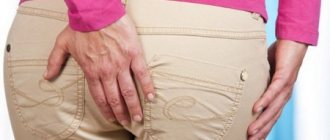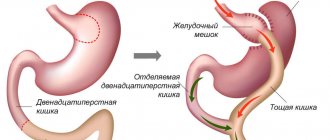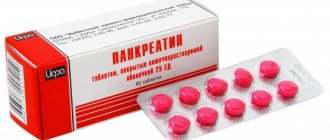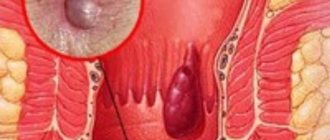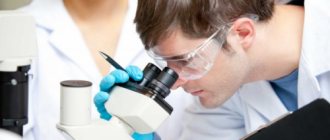Symptoms
At the most acute stage of thrombosis of hemorrhoids, the following symptoms develop:
- defecation is painful
- excruciating pain,
- urinary retention,
- development of inflammation,
- increased body temperature,
- edema.
The nodes themselves have a purplish-blue tint, and some areas even acquire a black tint, which is characteristic of necrosis. Bleeding can be noticeable already in the last stages of the disease, and ulcers open on several nodes at once. Sometimes it happens that the resulting blood clot comes out of the damaged vein on its own. In such cases, a person experiences significant relief, but it is deceptive. Delay in going to the hospital can lead to serious blood loss.
The pain often comes suddenly, and a particularly severe syndrome is observed with prolonged compression of the veins by the opening of the anus. It can subside only with ordinary hemorrhoids, and with thrombosis, the pain syndrome does not go away even with complete rest, if no treatment is taken.
Causes of thrombosed hemorrhoids
Proctologists are unanimous in the opinion that thrombosis occurs due to dysfunction of the rectal vessels. In the case of increased inflow of venous blood and weak outflow of arterial blood, the veins become tense, overfilled, dilated, and, as a result, hemorrhoidal cones appear.
Not a single pathology in the functioning of organs of the human body, including hemorrhoidal thrombosis, can arise on its own.
Thrombophlebitis of the hemorrhoidal veins of the anus may appear and begin to develop in the presence of the following factors:
- The movement of blood in the pelvis is disrupted. Most often it happens if a person, due to work needs or simply because of laziness, practically does not move and does not engage in any sports exercises.
- Disruption of the vessels of the rectum. The walls of blood vessels in the rectum “coarse” and lose elasticity. This occurs due to regular and significant physical activity or when a person is often in an upright position.
- Gastrointestinal dysfunction. Constipation, or, conversely, diarrhea, often leads to thrombosed hemorrhoids. With constipation, the rectum is subjected to real overload, and the normal movement of blood is disrupted. With regular diarrhea, constant inflammatory processes occur in the rectum.
- Non-compliance with diet and poor nutrition. Lovers of fatty, smoked, and salty foods suffer from the presence of a blood clot in the hemorrhoidal area.
- Bad habits. Alcohol and smoking lead to blood stagnation, the inability of blood vessels to cope with the inflow and outflow of blood.
- Benign and malignant formations in the pelvic area. Inflammation associated with other diseases. In such situations, there is an increase in blood flow, the veins cannot cope with the “work”, and as a result, stagnation occurs.
- Involuntary contractions of the pelvic muscles, pain. Due to such phenomena, the veins are compressed, subject to injury.
- Pregnancy and gestation. The size of the uterus increases, it puts pressure on the pelvic vessels, and blood flow to the rectum is disrupted. In the process of bearing a child, thrombosis of both internal and external hemorrhoids quite often occurs.
- The process of childbirth. The pressure in the pelvic area increases significantly, and under the influence of blood pressure, vasodilation is observed. Normalization of blood flow takes time, but even short-term stagnation causes blood clots.
Blood clot formation due to hemorrhoids
Thrombosis of the external hemorrhoid is not an independent disease. This pathology is a complication of hemorrhoids. It develops when the problem is ignored or treated incorrectly. The basis is a violation of blood circulation in dilated veins.
Vein blockage is observed in every fourth person with hemorrhoids. This is the most common complication of varicose veins of the anus.
The following forms of thrombosis are distinguished:
- outer;
- interior;
- combined.
If treatment is not done in a timely manner, complications (bleeding, suppuration) are possible.
Main etiological factors
In hemorrhoids, thrombosis is caused by several etiological factors:
- congestion in the pelvis;
- passive lifestyle;
- errors in nutrition;
- alcoholism;
- bowel dysfunction such as constipation or diarrhea;
- mechanical damage;
- spasm of the sphincter of the posterior opening;
- acute pain.
If you have hemorrhoids, you should follow a diet. Blood clots often form in those people whose diet is dominated by spicy foods, coarse foods and fatty foods. Excess salt in the diet has an adverse effect on blood vessels. A risk factor is the lack of foods rich in fiber (dietary fiber) in the menu. These include vegetables, fruits and berries.
Blood stagnation and thrombosis of hemorrhoidal veins can be caused by constipation. Slow intestinal motility and hard stool lead to vascular damage and the formation of clots.
In women, the formation of a thrombosed hemorrhoid often occurs after childbirth and during pregnancy.
The risk group includes people who move little. External hemorrhoids are characterized by prolapse of a node or nodes. If you sit for a long time, the knot may become pinched. This leads to blood stagnation and blood clot formation.
This pathology often develops against the background of acute pain syndrome. The cause is a pronounced spasm of the sphincter, which contributes to the development of hemorrhoidal thrombosis.
Mechanism of blood clot formation
External thrombosed hemorrhoids are associated with several pathological processes. It is based on the expansion of the veins in the anus. They become thin, crimped and long. First, internal hemorrhoids develop, then the nodes come out. In severe cases, they cannot be adjusted and can become pinched during daily activities.
Education is based on the following processes:
- slowing down the flow rate of venous blood;
- compression of blood vessels;
- mechanical damage to veins.
Prevention
Acute thrombosis of hemorrhoids often becomes chronic. By following preventive measures, this can be prevented. The main attention is paid to the normalization of stool, since it is its violations that lead to hemorrhoids. It is necessary to follow a diet throughout your life. Spicy foods are excluded from the diet, and the amount of fried and salty foods is reduced. Foods rich in fiber are welcome - cereals, vegetables, fruits. It is recommended to replace white bread, which causes constipation, with rye, grain or bran. It is also necessary to consume the required amount of fluid.
Daily exercise will be beneficial. This will also help improve intestinal motility, maintain intestinal tone and prevent diarrhea or constipation. Excessive loads, on the contrary, should be avoided. Those people whose work requires staying in one position for a long time should take short breaks and stretches every few hours.
If a patient has problems with blood clotting, then he needs to undergo a course of treatment aimed at solving this problem.
Types and degrees of disease
Types of thrombosis in hemorrhoids are distinguished based on the localization of the pathological process:
- external - the most common, it affects the external hemorrhoid;
- internal – damage to the internal node;
- mixed - blood clots form both on the inside and outside of the anus; it is rare.
According to clinical manifestations, perianal venous thrombosis is divided into three degrees of severity, differing in symptoms:
- The first degree of severity is not accompanied by inflammation, the patient is bothered by burning, pain during bowel movements, and itching. Symptoms intensify when eating spicy, salty foods, alcohol, physical activity or prolonged sitting. Redness of the skin and mucous membrane in the anus appears, elastic formations are found that are painful on palpation. If at this stage internal nodes are involved in the pathological process and an inflammatory process is added, thrombophlebitis develops.
- The second degree of the disease is accompanied by constant pain, which intensifies while walking or when sitting for a long time. The act of defecation is also accompanied by unpleasant sensations, bleeding occurs, and body temperature is elevated. In the anus there is redness, swelling and pain on palpation. External and internal hemorrhoids are inflamed, enlarged, swollen, and sharply painful.
- The third degree of pathology is manifested by severe pain, as a result of which the sick person cannot sleep peacefully and perform work activities. The body temperature is elevated, the act of urination is disrupted as a result of a reflex reaction. Hemorrhoidal cones are dense, swollen, turn blue-purple, and show areas of necrosis and fibrin deposits. The tissues of the anorectal area are hyperemic, inflamed, and painful.
Causes
Thrombosis of the internal hemorrhoid occurs due to impact on the wall of the venous plexus. This causes stagnation of blood and, as a result, the formation of blood clots. Thus, the lumen of the vessels is partially blocked, which complicates the flow of blood. Because of this, the disease develops. The tena of the venous plexus can be injured as a result of hypothermia, mechanical damage to the tissues of the anal area, or a sharp jump in intra-abdominal pressure, which increases during:
- pregnancy and childbirth;
- excessive physical activity;
- constipation, diarrhea.
Patient examination plan
Before treating a person, you need to make a correct diagnosis. The following pathologies must be excluded:
- acute and chronic fissures of the anus;
- rectal cancer;
- ulcerative colitis;
- polyps.
Questioning the patient, examination and digital examination are of great diagnostic importance. The treating physician must review the person's medical record. If hemorrhoids were previously diagnosed, then thrombosis can be suspected. To confirm, you need to undergo an instrumental study. It is indicated in doubtful cases.
The most informative is sigmoidoscopy. This procedure has contraindications: massive bleeding, mental disorders, narrowing of the intestine and acute paraproctitis.
In most cases, an external hemorrhoid can be identified during examination and digital examination. The following changes are determined:
- edema;
- hyperemia;
- soreness;
- purplish-blue and black color of the skin in areas of necrosis.
Treatment of thrombosed hemorrhoids is carried out only after general clinical tests and a coagulogram. The latter allows you to assess blood clotting ability.
Development mechanism
Based on the localization of the pathological process, the following are distinguished:
- Acute external hemorrhoids;
- Acute internal hemorrhoids;
- Combined thrombophlebitis of nodes (diagnosed in more than 80% of cases).
The gradation of clinical manifestations and the severity of pathological changes traditionally has 3 degrees:
I degree - if the external nodes are affected, they are visualized as densely elastic, bluish, small nodes at the border of the anal canal mucosa and the skin of the perianal zone. Internal nodes may not be visible, but their thrombosis gradually leads to the spread of perianal edema; external intact nodes are moderately painful and hardened.
Hemorrhoidal complexes, as a rule, are grouped in traditional localization at 3, 7, 11 o'clock on the conventional dial in the supine position.
The skin near the anus is hyperemic. By palpation (after pressing), short-term pallor is determined at the site of the impression. Subjective sensations of patients include moderate itching, burning, pain in the area of the cavernous plexuses. Manifestations intensify during defecation, on a hard seat, after hot, spicy food, and drinking alcohol.[1]
Thrombosis of the external hemorrhoid without inflammation (grade 1)
II degree - symptoms increase significantly, often due to pain and increasing spasm of the anal sphincter, digital examination is impossible. Patients complain of severe pain during movement, are forced to choose a position when sitting, and arbitrarily delay defecation. Local hyperemia, pain and swelling of the skin may give reason to suspect acute paraproctitis. But with the latter, as a rule, the pain is asymmetrical and not so pronounced. Sometimes with paraproctitis, it is possible to determine the involved wall of the rectum on the affected side, fluctuation. Paraproctitis is characterized by delimitation of hyperemia.[5]
III degree. The symptoms are extremely pronounced and disrupt the patient’s normal functioning. Possible urination disorder, even anuria. Inflammatory changes are extremely pronounced, sharp swelling and hyperemia of the entire perianal zone - circular infiltration of the sphincter, separate groups of hemorrhoids merge into a single conglomerate. It is impossible to conduct a digital examination; even palpation brings a lot of painful sensations. Sometimes swelling and infiltration are similar to the clinical picture of strangulation of internal nodes. If the nodes actually fall out, they cannot be repositioned. Gradually, the cyanotic nodes begin to become necrotic.
The State Research Center has developed a classification of acute hemorrhoids that takes into account the degree of inflammatory changes, where grade 1 is thrombosis without any reactive tissue changes. 2nd degree - inflammatory reactions of the involved nodes are determined. 3rd degree - tissue reaction not only in the cavernous plexuses, subcutaneous tissue is affected by inflammation, swelling of the skin of the perianal zone, necrosis of the mucous membrane is determined.
Removing external nodes
How to treat if nothing helps? When conservative methods are ineffective, they move on to surgical intervention. Removal of nodes is prescribed for patients with greatly enlarged external hemorrhoids, while the inflammatory process in this case extends to the distal part of the anus and to the tissues of the perianal area.
Surgical treatment is a quick way to forget about the problem
When operating on a hemorrhoid, minimally invasive surgical methods are used. As a result, the intensity of blood flow in the node decreases, and the hemorrhoid itself decreases in size. For each patient, the operation is selected individually, in accordance with the leading symptoms that accompany the disease.
Surgical treatment methods:
- ligation;
- sclerosis;
- infrared photocoagulation;
- disarterization of nodes.
In the most advanced stages of the disease, thrombectomy is performed - excision of nodes with a scalpel.
At the first manifestations of external hemorrhoids, they consult a coloproctologist, who will tell you how to remove the external hemorrhoid in the easiest way in a particular case. Treatment of the external form of the disease in the initial stages will help to avoid complications and prevent the pathology from moving into a more severe phase of development.
Important
The appearance of thrombosis of hemorrhoidal cones during pregnancy
Hemorrhoids can occur during pregnancy. In the initial stages, the disease proceeds unnoticed. Most often, the problem is identified during the next gynecological examination, but sometimes a woman notices the disease when she feels severe pain. In severe cases, thrombosis of the hemorrhoid occurs, which is dangerous during pregnancy. During childbirth, tissue ruptures are common, and the venous plexuses in the anus can also be injured.
Treatment for pregnant women excludes any surgical interventions. It is based on following a diet, performing a set of therapeutic exercises and using certain medications.
Hemorrhoids can occur during pregnancy
Risk factors and groups
The following risk factors for thrombosis can be identified:
- excess body weight;
- burdened heredity;
- physical inactivity;
- frequent stressful situations;
- inflammation in the intestines, liver;
- smoking, drinking alcoholic beverages.
The more risk factors a person has, the higher the risk of developing pathology in a more aggravated form.
The following people are at risk for developing pathology:
- with obesity;
- sitting workers - office workers, teachers, drivers and others;
- working at heights - installers, flight attendants, pilots;
- with hereditary predisposition.
Diagnosis of thrombosis
The examination is carried out in the most comfortable position for the patient!
A comprehensive diagnosis is carried out for a more complete and in-depth study, allowing you to see the full clinical picture of the disease:
- Digital examination of the rectum
- Hardware diagnostics Videoanoscopy
- Video sigmoidoscopy
Depending on the clinical symptoms and complaints (for example, a complaint that the anus is itchy), the proctologist may prescribe additional examination methods.
Treatment of thrombosed hemorrhoids (complicated by nodes and thrombosis)
The course of hemorrhoids has four stages. It is known that the first and second stages can often be asymptomatic or cause slight discomfort, while the third and fourth stages of the disease are characterized by severe symptoms and are often accompanied by complications. The main complications include thrombosed hemorrhoids (see photo).
Formed hemorrhoids in the rectal cavity and near the anus can be easily treated if you consult a doctor in a timely manner. But it should be noted that if thrombosed hemorrhoids have already occurred, this means that the disease is advanced and has acquired a chronic form, which can often worsen. This condition is always accompanied by severe pain, so treatment of thrombosed (thrombotic) hemorrhoids should be immediate.
What is node thrombosis?
One of the reasons for the formation and enlargement of hemorrhoids in the rectum is poor blood flow from the pelvic organs. Thus, the process of blood stagnation occurs, as a result of which clots (thrombi) can form.
Hemorrhoid thrombosis has three stages:
- First: blood microcirculation is disrupted, as a result of which small blood clots appear in the nodes, which make them painful. In addition to pain, there is itching and a feeling of discomfort. Around the anus, small convex bumps that are dark red in color can be felt with your fingers. This stage does not cause inflammation.
- Second: if you do not consult a doctor in time and do not begin treatment for hemorrhoid thrombosis, then at this time an inflammatory process occurs in the affected node, which can spread to the surrounding tissues. The bumps become large, severe acute pain and swelling of the skin are felt. Often your body temperature may rise.
- Third: the inflammatory process progresses, involving the surrounding tissues. The pain becomes unbearable, necrosis of the node itself is often observed, which becomes the beginning of the development of purulent paraproctitis.
Thrombosis with hemorrhoids always has severe symptoms that occur suddenly. The most common symptoms are severe pain, bleeding, enlargement and inflammation of the hemorrhoids, which are often accompanied by necrosis. With a common disease, pain can appear under the influence of provoking factors (damage to the node with feces, lifting weights), and if we are talking about hemorrhoids with thrombosis, then pain is always present. The patient, even at rest, is exhausted by severe pain, which becomes unbearable during bowel movements. This forces you to refrain from bowel movements, causing constipation, which only makes the situation worse.
In this case, it is necessary to urgently begin treatment for node thrombosis in hemorrhoids, which will be aimed at eliminating the symptoms and relieving the exacerbation. To relieve pain, the doctor prescribes analgesics and non-steroidal anti-inflammatory drugs (Ibuprofen, Diclofenac). To improve blood circulation and reduce the node, local ointments (Relief, Hepatrombin G, Proctosedyl), gels or creams, as well as suppositories can be used. Drugs that strengthen the walls of blood vessels and make them more elastic (Phlebodia 600, Detralex, Movalis) have a good effect. Sitz baths and compresses made from herbal decoctions sometimes have a relieving effect.
Blood clot removal
Often conservative treatment can alleviate the acute manifestation of symptoms and put the disease into remission. But it happens that it is necessary to urgently apply surgical intervention, which is performed under general or local anesthesia. With local anesthesia, a painkiller is injected under a blood clot for hemorrhoids, after which a small incision is made and the clot is removed. Often the doctor may decide to remove the inflamed node. To completely cure hemorrhoids, the blood clot and the node must be completely removed, since this prevents subsequent accumulation of blood in the node.
Many experts recommend first stopping the inflammatory process in blood clots in hemorrhoids (thrombophlebitis) using conservative methods, and performing surgery in the remission stage.
After surgery, the patient is prescribed painkillers and anti-inflammatory drugs. These medications include Thrombo ACC, the main active ingredient of which is acetylsalicylic acid. Thrombo ACC for hemorrhoids is prescribed to prevent the formation of blood clots, it speeds up postoperative recovery.
varikoz.org>
Possible complications and consequences
Complications that arise due to lack of treatment can be different. These include:
- formation of paraproctitis (inflammatory process in pararectal tissue);
- the appearance of edema;
- development of bleeding;
- node infringement;
- necrotic changes in the tissue of the node;
- pulmonary embolism.
After treatment, the occurrence of adverse reactions decreases several times.
Recurrence of thrombosis is possible. To prevent this, you need to stick to a diet and avoid intense physical activity.
To prevent external thrombosis, you should follow a proper diet, exercise, and reduce or eliminate exposure to bad habits for people at risk. If you experience discomfort during bowel movements, you should consult a doctor so that, if necessary, timely treatment is carried out.
Against the background of untreated or inadequately treated exacerbation of hypertension, the following may occur:[14]
- necrosis of the epithelium or mucous membrane over thrombosed nodes;
- formation of infected wounds at the site of necrotic changes, paraproctitis;
- bleeding, sometimes quite profusely, from the wound in the area of the hematoma.
The main complication is necrosis. It can be partial or complete. It primarily affects inflamed or thrombosed veins and then affects nearby areas. The cause of necrosis is a violation of blood circulation due to venous stagnation or compression of the affected plexus by the sphincter muscles.
The main complication is necrosis
Against the background of proctological pathologies, immunity is noticeably reduced, which, together with inflammation, can cause paraproctitis - suppuration of the subcutaneous tissue near the rectum. This happens due to the entry of infectious agents (staphylococci, E. coli, etc.) into the tissues from the feces. This condition threatens blood poisoning, melting of the intestinal walls, as well as the development of peritonitis (pus penetrates into the abdominal cavity).
Complications of thrombosis of the perianal veins with hemorrhoids occur if there is no treatment in the next 24 hours. Common complications include:
- inflammation of the submucosal tissue - paraproctitis;
- massive swelling in the rectal canal;
- necrotic changes with death of intestinal tissue;
- pulmonary embolism.
Complications are also possible after surgery: adhesions, secondary infection due to non-compliance with hygiene or antiseptic standards.
In some cases, the pathological process with thrombosis of hemorrhoids spreads to the entire perirectal tissue, purulent paraproctitis develops with the formation of an abscess in the soft tissues. In severe cases, sepsis may occur. Of other complications, the most common are intense bleeding, widespread swelling in the rectal area and necrosis of hemorrhoids.
Conservative treatment of thrombosis
To treat hemorrhoidal thrombosis, doctors use an integrated approach, which is selected differentially, taking into account the stage of microcirculation disturbance. Conservative therapy is usually resorted to if the patient is diagnosed with the first and second degrees of the disease, as well as during pregnancy.
The main objectives of the treatment of thrombotic hemorrhoids are:
- eliminating pain and swelling of tissues;
- stopping the inflammatory process and reducing the severity of the clinical picture;
- relaxation of the anal valve;
- getting rid of a blood clot and preventing thrombosis.
Conservative therapy for thrombotic hemorrhoids includes the use of thrombolytics - drugs that accelerate the resorption of blood clots and eliminate pain.
For external hemorrhoidal thrombosis, ointments are applied to the anus:
- Troxevasin;
- Hepatrombin;
- Ultraproct;
- Heparin ointment.
In addition, thrombolytic agents have a good effect in the fight against hemorrhoidal thrombus.
If, with hemorrhoids, a hard ball is localized inside the rectum, then treatment is carried out using rectal suppositories. Most often, in case of pathology, the following ointments and suppositories are prescribed for hemorrhoidal thrombosis:
Anestezol helps relieve pain;
- Nigepan is a thrombolytic suppository for hemorrhoids with thrombosis, and their effect is enhanced by the anesthetic;
- Posterisan contains inactivated bacteria.
Often, hemorrhoid thrombosis is treated using ointments and rectal suppositories in combination with venotonic agents. Such medications have a stimulating effect on blood flow, increase the tone of the veins and relieve swelling of the nodes. Detralex is considered an effective drug from the venotonic group. It reduces vascular permeability, helps to tone the venous walls and reduces the distensibility of blood vessels. When treating hemorrhoidal thrombosis during pregnancy, the number of approved medications is significantly reduced, and they are prescribed only by a doctor.
Thrombless for hemorrhoids is an antithrombotic drug that is intended for external use. This ointment for thrombosis of hemorrhoids must be used in the form of rectal tampons and helps to quickly relieve the inflammatory process and pain.
Thrombo ass for hemorrhoids is a medication that belongs to the group of non-steroidal drugs with an anti-inflammatory effect. The product thins the blood well, helps prevent the formation of blood clots, eliminates pain and inhibits the inflammatory process.
Many ointments and suppositories for hemorrhoidal thrombosis have simultaneously anti-inflammatory, antibacterial, analgesic and antithrombotic effects. It is possible to alleviate the patient’s condition with the help of drugs such as Aurobin, Proctosedyl and Nigepan.
Conservative treatment of thrombosis for hemorrhoids includes not only taking medications, but also observing the following rules:
- it is necessary to observe bed rest;
- you need to reconsider your diet, which will help prevent constipation and facilitate bowel movements;
- if possible, do enemas and take laxatives;
- wash with cold water several times a day.
In case of thrombosis of the external hemorrhoidal node and cones of internal localization, one cannot do without anticoagulants, and Heparin is considered the most famous drug in this group.
Choice of treatment tactics
The treatment process is built taking into account the characteristics of the pathological condition, the stage of thrombosis and other clinical criteria. Treatment can be conservative, surgical, or a combination of both.
Drug therapy is used at stages 1-2 of thrombosis and consists of prescribing the following drugs:
- phlebotonic (“Detralex”);
- anti-inflammatory (“Indomethacin”, “Diclofenac”);
- local antiseptics with solutions of “Furacilin”, “Miramistin”, “Chlorhexidine”;
- anticoagulant (Troxerutin, heparin ointment).
Painkillers are prescribed individually, depending on the severity of the pain syndrome. Sometimes local or systemic administration of non-steroidal anti-inflammatory drugs and novocaine blockades are required.
For long-term therapy and to avoid relapses, heparin-based blood thinners are indicated. In addition, a long course of venoprotectors is required to strengthen the vascular walls.
In most cases, surgical intervention is indicated, which involves destroying the blood clot inside the vessel or removing the hemorrhoid.
There are 2 methods of treatment - conservative and surgical. Conservative treatment is used for grades 1 and 2. It consists of following a diet, taking medications orally and local treatment.
The diet consists of normalizing the activity of the digestive tract by consuming enough dietary fiber per day. These include: bran from wheat, oats, seaweed, flax seeds, vegetables and fruits.
Meals should be at least 4-5 times a day in small portions. It is necessary to exclude the intake of fatty, fried, spicy foods, and alcohol.
Local treatment - lotions moistened with antiseptic solutions (furacillin, potassium permanganate).
Drug treatment:
- Elimination of pain syndrome - Proctosan, Aurobin, Ultraproct, Relief and other drugs.
- Anticoagulants – Heparin ointment, Troxerutin.
- Phlebotonics – Detralex.
- Anti-inflammatory therapy - Diclofenac, Indomethacin.
- For bleeding, local hemostatic drugs are indicated - Phenylephrine, sodium alginate.
Surgical treatment is prescribed for stage 3 thrombosis. An operation is performed to excise the hemorrhoid and remove the blood clot - thrombectomy. In severe cases, the node itself is removed - hemorrhoidectomy.
At different stages of the disease, thrombosis of the hemorrhoidal node involves treatment with conservative or surgical methods. Drug therapy is prescribed throughout the disease, regardless of the degree of damage. Many patients feel embarrassed about their problem, so when they discover they have a hemorrhoid, they buy ointment at the pharmacy without consulting a specialist. The effect of ointments in the treatment of this disease cannot be denied, however, this remedy should also be selected by a doctor.
The goal of pharmacological therapy is to:
- preventing or relieving inflammation;
- eliminating swelling;
- pain relief;
- dissolving and preventing blood clots;
- relaxation of the sphincter.
Drug therapy is prescribed throughout the disease, regardless of the degree of damage
Most thrombolytics cope well with these tasks. Therapy is supplemented with venotonics to increase vascular tone and improve blood circulation: (“Aescin”, “Detralex”).
For the external form of the disease, the use of ointments that are applied directly to the affected area will be effective: (“Ultraproct”, “Troxevasin”, “Levomekol”, “Heparin ointment” and others).
If the cones are located internally, suppositories can be used if their administration does not cause pain. They have both a local and general effect: (“Anestezol”, “Nigepan”, “Relief Advance”).
Surgical methods are resorted to when thrombosis of the hemorrhoid does not respond to conservative treatment, as well as in the later stages of the disease. Urgent surgery is required for bleeding. In this case, two types of operations are relevant:
- resection (for external form);
- thrombectomy.
To prevent relapses, they resort to minimally invasive operations - linging, sclerotherapy or infrared coagulation. All interventions are performed under local anesthesia and do not require the patient to stay in the hospital.
You must follow a diet throughout your life
For treatment, specialists in the field of clinical proctology use complex therapy, which is determined differentially depending on the degree of microcirculation disturbance. For the first and second degrees of severity, multicomponent conservative therapy is justified. Thrombolytic agents are prescribed in the form of gels, ointments or suppositories. These are heparin-based drugs that are highly effective in eliminating thrombosis and preventing the formation of blood clots in the future. Painkillers are also used to relieve intense pain and improve the condition of patients. If there are signs of inflammation, non-steroidal drugs and glucocorticoids are prescribed.
Anti-inflammatory treatment is prescribed locally in the form of ointments, as well as orally or parenterally. With an active inflammatory process, a combination of local treatment with intramuscular or intravenous administration of anti-inflammatory drugs is possible. Drugs with a venotonic effect are also used. As an additional conservative treatment, patients are advised to apply cold compresses to the perineal area, which can eliminate pain and reduce the severity of inflammation.
The third degree of thrombosis of hemorrhoids is an indication for surgical treatment. The operation can be performed urgently (within the first two days) or delayed (after 4-5 days), which is determined by the presence or absence of pinched nodes and the need to relieve acute inflammation. The most common operation is thrombectomy. This is a relatively small intervention that involves opening the node and removing the blood clot from it, after which proctological surgeons do not suture the postoperative wound, giving it the opportunity to heal on its own. Final healing takes no more than 2-3 days. This tactic is used for external thrombosis of one or two nodes.
For more extensive lesions, hemorrhoidectomy is performed to restore the integrity of the mucous membrane of the anal canal. This intervention allows you to achieve optimal long-term results. In some cases, with extensive thrombosis with severe perianal edema and severe pain, posterior dosed sphincterotomy is used. In the presence of complications, such as inflammation of the perirectal tissue or necrosis of the hemorrhoid, more radical surgical interventions are performed. Surgeries for paraproctitis involve drainage of the perianal tissue to reduce inflammatory infiltration.
If the nodes are not tense, there are no areas of necrosis, then this stage of the disease is treated with medication. To increase vascular tone, take venotonics, locally anesthetize and relieve inflammation with ointments and suppositories. The course of treatment takes on average 3 weeks. The standard set of medications includes:
- Ointments and suppositories such as Hepatrombin, Troxevasin, Levomikol, as well as Heparin ointment, Aescin gel strengthen the elasticity of blood vessels, resolve blood clots, and improve blood supply.
- In case of internal complications, suppositories are prescribed - Relief, Anestezol, Posterizan, Nigepan.
- You can anesthetize and soothe irritated skin of the anus with novocaine blockade, Aurobin ointment, and Polidecanol.
- The most popular venotonics are Petralex and Aescin. The course of taking tablets for deformities of hemorrhoids is long.
In case of exacerbation, complex conservative therapy is used - from intramuscular and intravenous injections to local treatment of the problem area with ointments and compresses.
Both domestic experts and foreign sources give unambiguous recommendations: in case of hemorrhoidal disease, acute conditions are treated conservatively, with a complex of systemic and local medications. In some cases, the use of physiotherapy (ultrasound and magnetic laser therapy) is very effective.
Systemic drugs are designed to normalize blood flow in the cavernous plexuses, improve microcirculation in tissues, reduce inflammatory manifestations, pain, and promote the activation of lymphatic drainage effect. The most proven ones:
- Micronized diosmin[11] (Vasoket, Detralex, Phlebodia, Venarus);
- Oral forms of NSAIDs - non-steroidal anti-inflammatory drugs (Ibuprofen, Nimesulide).
Local pharmacotherapy is aimed at reducing swelling, analgesia and anti-inflammatory effects directly in the hemorrhoidal plexuses, as well as an anticoagulant effect. Ointment and gel forms are applied several times a day until the main manifestations are relieved (on average 7-10 days). The optimal drug with a combined composition is Hepatrombin G. Another ointment with a combined effect is Proctosan. They contain glucocorticoids, analgesics, bismuth subgallate, NSAIDs, and titanium dioxide.
The content of the active substance in monocomponent heparin-containing ointments should be at least 1000 IU.
The use of surgical methods alleviates the patient’s condition as quickly as possible and prevents relapses, but the operation is most effective in the early period (up to 3 days from the onset of thrombophlebitis of the cavernous plexuses of the distal parts of the large intestine).[2]
The most popular methods for surgical treatment of exacerbation of hypertension are minimally invasive methods:
- Enucleation (husking) of a blood clot;
- Thrombectomy with surgetron;
- Thrombectomy with surgetron using a laser to coagulate the vessels supplying the node.
Enucleation, as well as thrombectomy for acute thrombophlebitis of external hemorrhoids, is used:
- If there is a danger of damage to the integrity (rupture) of the epithelium over the perianal hematoma;
- If the perianal hematoma is located superficially;
- If a single thrombus is diagnosed.
Rupture of the epithelium over a thrombosed hemorrhoid. Late appeal
The enucleation method gives a good clinical effect in terms of improving well-being, relieving pain, swelling, etc. Among the disadvantages are possible relapses of acute thrombosis in the same node (since the vessels supplying the cavernous plexus remain).
For multiple hematomas of the perianal zone (thrombosis), hemorrhoidectomy is performed.
The intervention is carried out in a hospital setting if there is a pronounced widespread inflammatory reaction in the perianal area, in the rectum. The use of modern UltraCision and LigaSure technologies when removing nodes reduces pain in the early postoperative period, reduces the period of disability after surgery, and reduces the incidence of dysuric postoperative disorders.[9][10]
Treatment of hemorrhoidal thrombosis
The treatment regimen for thrombosis of hemorrhoidal cones includes:
- drug therapy;
- surgical interventions;
- minimally invasive techniques.
Drug treatment
The drug therapy regimen for hemorrhoidal blockage includes:
- Thrombolytic agents for local treatment (Hepatrombin G, Troxevasin, Proctosedyl, Vishnevsky ointment). Ointments are applied to inflamed and thrombosed cones 2 times a day, suppositories are administered at night. Regular use of the drugs helps dissolve blood clots, eliminate signs of inflammation, and normalize blood circulation.
- Antispasmodics (No-shpa, Platifilin, Buscopan). Intramuscular injections and rectal suppositories relieve spasm of the anal sphincter, and pinched hemorrhoidal veins are released.
- Anti-inflammatory and painkillers (Diclofenac, Nimesil, Novocain). Used in cases of severe pain and inflammation of the anal tissues.
- Venotonics (Detralex, Phlebodia). Increases the tone of vascular walls, relieves swelling.
- Laxatives (Forlax, Duphalac). They normalize intestinal function and prevent constipation, which aggravates the severity of the disease.
Minimally invasive
Such operations are used in the presence of small thrombosed hemorrhoids and the absence of complications. The doctor may prescribe:
- Sclerosis. The drug is injected into the hemorrhoidal cone, causing the walls of the affected vessel to stick together. The procedure is supplemented with infrared irradiation, which reduces the intensity of pain and inflammation. Used when there are small nodes.
- Ligation. It is used in the late stages of thrombosis of hemorrhoids that have formed bases. Latex rings cut off the blood supply to the cones, causing them to be rejected 1-2 weeks after surgery.
- Infrared coagulation. During the procedure, the hemorrhoid is heated with a quartz LED. Adhesions form at the base of the node, preventing the blood clot from penetrating into the circulatory system. The dilated portion of the vessel dies after a few days.
- Desarterization. The arteries supplying the hemorrhoid are ligated under local anesthesia, which prevents the movement of the blood clot and promotes rejection of the lump. The effectiveness of the operation is close to 90%.
Surgical
If a conservative approach and minimally invasive techniques are ineffective, surgery is prescribed. There are 2 types of surgical interventions used to eliminate thrombosis of hemorrhoids:
- Resection of hemorrhoidal veins. The most effective way to eliminate external thrombosis. Resection not only gets rid of the blood clot, but also the cause of its occurrence. Relapses do not occur after such an operation. The intervention improves the quality of life due to the absence of prolapsed nodes.
- Thrombectomy. The operation is performed using a laser beam or scalpel. The clogged hemorrhoidal cone is opened, the blood clot is removed, and the walls of the vessel are sutured.
Folk remedies
The use of alternative medicine is allowed at an early stage of the disease after prior consultation with a doctor. To alleviate the condition of blockage of the rectal veins at home:
- Sitz baths with birch decoction. 100 g of leaves are brewed with 2 liters of boiling water and left for 2 hours. The resulting liquid is filtered and poured into a basin. The bath is taken for 20 minutes.
- Hirudotherapy. Leeches are purchased at a pharmacy and placed on each clogged node. The saturated leech disappears on its own, the blood clot dissolves, and the lump decreases in size.
- Birch tar. When hemorrhoidal veins are blocked, lotions and tampons soaked in this substance are used.
Diet for thrombosis of hemorrhoidal veins
An unbalanced diet is one of the reasons for the exacerbation of hemorrhoids. We often think about a diet when hemorrhoids and their exacerbations have already made themselves known, not realizing that with regular adherence to it, thrombosis might not have occurred.
The consumption of hot spices, fatty meats, canned food, smoked meats, and alcohol increases the flow of blood to the abdominal cavity and the overflow of the pelvic veins with blood. This is how hemorrhoids become inflamed.
Follow a diet that prevents thrombosis. Helps normalize blood density:
- Vegetables and fruits;
- Cereals (buckwheat, barley, oatmeal, barley);
- Lean meat;
- Cold sea fish, rich in beneficial acids;
- Fermented milk products;
- Vegetable oil.
To normalize intestinal function and reduce low-density lipoprotein levels, plant fibers must be present in therapeutic nutrition.
During this period, special attention is paid to the prevention of constipation, which increases the load on hemorrhoids.
Fiber will help normalize the state of intestinal microflora, which takes an active part in the digestion process, and improve the consistency of stool; there is a lot of it in cereals, fresh vegetables and fruits.
Salmon, mackerel, and sardines contain high concentrations of Omega-3 polyunsaturated acid. Their use helps improve triglycerol and hematocrit levels.
Garlic and ginger thin the blood. Products with flavonoids, such as red grapes, grape juice, and dry wine, improve its composition.
Products containing vitamin E are useful: sprouted wheat grains, sunflower and flax seeds, olive and flax oils, baked goods with bran and wholemeal flour.
Compliance with the drinking regime reduces blood viscosity, loosens the consistency of stool for free movement in the rectum, since the pressure of dense stool injures inflamed nodes and contributes to the appearance of anal fissures.
Avoid fast food, hydrogenated fats, processed foods, fatty meats, chocolate, legumes, canned food, cheeses, smoked meats, and baked goods from the diet. Sugar, carbonated drinks, refined flour, offal are also on the black list. There are also restrictions on the number of eggs: no more than three yolks per week.
You can normalize digestion with split meals: 5-6 times a day. Cook food in a steamer, microwave, oven.
The range of products allowed for thrombosis is wide enough to create a delicious menu and not feel deprived.
Knowing the prerequisites and mechanism of formation of thrombosis of hemorrhoidal veins, following preventive measures, you can largely avoid such complications and improve the quality of life with varicose veins of hemorrhoidal veins.
Treatment options
When prescribing a treatment method, they look at the stage the disease has reached. The following methods are commonly used:
- medicinal;
- surgical.
Below we will talk about each method of treating thrombosed hemorrhoids in more detail.
Medication method
It allows you to eliminate symptoms in about a month and a half, and then follow some recommendations that are aimed at preventing a relapse. It is used mainly in the first and second stages of the disease, eliminates pain and inflammation, improves blood circulation.
When treating with this method, a number of rules are followed:
- the patient is prescribed bed rest;
- a special diet is prescribed to prevent constipation - including vegetables, fruits, and bran in the diet;
- giving up alcohol;
- taking laxatives;
- enema procedures;
- various compresses;
- taking baths in a sitting position with potassium permanganate;
- washing with cool water four times;
- cooling lotions;
- treating the affected area with special ointments;
- taking special medications.
The list of medications prescribed for the treatment of node thrombosis is quite extensive. Here are some of them:
- Heparin ointment - helps to dissolve blood clots, reduce inflammation and swelling.
Apply a small layer to the disturbing area. Or it is applied to a piece of fabric and applied to problem areas. Apply one to three times a day. - Detralex - the drug increases the tone of the veins.
- Prednisolone - helps reduce inflammation, swelling and itching. Use only as directed by a physician.
- Dufolac is a laxative that is used to improve bowel function.
- Polidocanol is an anesthetic used as an injection.
- Levomekol is an ointment with an anti-inflammatory effect.
- Posterizan - anesthetic suppositories.
- Proctoglivenol - helps reduce pain and inflammation.
Surgery
It is used in severe cases when other methods do not give the desired effect and thrombosis has reached the third stage.
Two types of operations are performed in case of thrombosis in hemorrhoids:
- Thrombectomy is a simple and quick way to remove a blood clot. Used for large hemorrhoids under local anesthesia. The protruding node is dissected by the surgeon, the incision reaches 5 millimeters and heals in about 4 days.
It is considered a fairly effective method of combating external thrombosis. However, it does not exclude the formation of a blood clot in a nearby nodule. To avoid this, you must follow all doctor's instructions.The video below shows how thrombectomy works:
- Hemorrhoidectomy - prescribed when the frequency of exacerbations becomes very high.
It removes not just a blood clot, but the entire nodule, which saves the patient from relapses. In the video you can see how this operation takes place:
With the development of technology, new methods of treating thrombosis have begun to be used:
- Laser thrombectomy.
Used to influence external nodes. Performed with local anesthesia. The pain stops after the procedure, and the anus is not subject to deformation. - Ligation.
Hemorrhoids are compressed with latex rings. Using an anoscope, the doctor gains access to the nodes and installs rings. After clamping, the node is deprived of power and gradually dies. It is used in the second and third stages. - Infrared coagulation.
Using a coagulator, the nodule is exposed to a beam of infrared rays. They burn the mucous membrane near the nodule and form a scar. It prevents the flow of blood and eventually it becomes depleted and disappears.
How to recognize hemorrhoid thrombosis
Signs of hemorrhoidal blood clot formation may include:
- The appearance of compactions in the rectum area;
- Blue-purple hue of formations;
- Blood discharge - on paper, in feces and underwear (regardless of the time of bowel movement);
- Sudden pain in the rectal canal;
- Discomfort in the rectum.
The pain from thrombosed nodes is long-lasting, not associated with trips “out of great need.” The bumps are hard and dark, and the sensation of the presence of something extra in the intestines intensifies.
The danger of the condition is that it causes mucosal necrosis and serious bleeding. Moreover, trouble does not come alone: the appearance of blood clots in the hemorrhoidal node is often accompanied by venous thrombosis of the lower extremities. When diagnosing thrombosed hemorrhoids, an ultrasound of the legs, as well as a blood test for coagulation, will not be superfluous.
With parallel pathologies, new complaints are added: hyperthermia, intoxication, general deterioration of health.
The severity of symptoms depends on the severity of the process:
- At the first stage, inflammation does not appear clearly. The nodes are slightly compacted, pain when touched is insignificant. The sensations of defecation aggravate when the effect of the presence of a foreign body intensifies. During the examination, slight redness and swelling are noted.
- At the next stage the process develops. It can be recognized by pronounced hyperemia and swelling. When palpating the problem area, patients complain of acute pain.
- The last, most severe degree, is characterized by the addition of infiltrate to the subcutaneous tissue of the problem area. Over time, the infiltrate covers the entire pararectal area. Palpation is not carried out at this stage, since any mechanical impact causes acute pain. The fallen nodes take on a purple hue.
In order to prevent the sad consequences of hemorrhoidal thrombosis (hemorrhage, suppuration, tissue necrosis, causing gangrene), it is important to undergo a timely examination in order to receive adequate treatment and not necessarily surgical treatment.
What can trigger thrombosis?
The thrombotic process of hemorrhoids is provoked by a number of reasons:
- sudden increase in pressure inside the abdominal cavity. A rapid increase in intra-abdominal pressure most often occurs in such cases - sudden increased physical stress, excessive effort during problems with passing stool (for example, constipation), pushing during labor;
- effect of low temperatures. Due to the rapid change in temperature, due to hypothermia, the blood in the vessels of the anus stagnates and stops circulating normally.
- Frequent tissue damage in the anus. Injuries around the hemorrhoidal cone are fraught with damage to the vessel, during which the blood coagulation system will be activated in order to repair the rupture of the wall. The work will involve platelets, coagulation factors, which will significantly block blood flow and increase the risk of a blood clot in the vessel.
But, it is necessary to understand that thrombosis in the veins of the rectum is already a consequence of an advanced and untreated disease. It should be considered as a complication. Therefore, the indicated reasons at the time of the initial stages will not have a dangerous effect in the occurrence of thrombosis.
In any case, to avoid any complications, it is necessary to seek specialized help in a timely manner.

